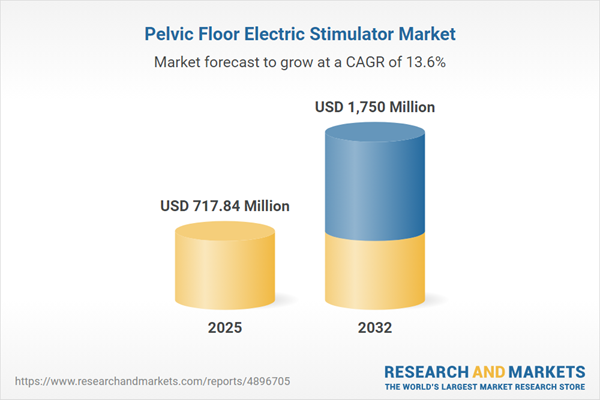Speak directly to the analyst to clarify any post sales queries you may have.
Senior leaders in the pelvic floor electric stimulator market face a dynamic landscape shaped by ongoing advances in medical device technology, evolving care delivery approaches, and complex procurement demands. Strategic adaptation is essential for both operational continuity and long-term competitiveness.
Market Snapshot: Pelvic Floor Electric Stimulator Market Overview
The global pelvic floor electric stimulator market is projected to expand from USD 631.53 million in 2024 to USD 717.84 million in 2025, registering a compound annual growth rate (CAGR) of 13.63%. By 2032, the market value is expected to reach USD 1.75 billion.
Drivers of growth include rising demand for minimally invasive solutions, integration of digital health technologies, and ongoing product innovation. Industry participants are strengthening their market positions by forming partnerships, optimizing distribution strategies, and focusing on regions with robust adoption and regulatory adaptability.Scope & Segmentation: Pelvic Floor Electric Stimulator Market
- Application Areas: Devices are designed to manage pelvic pain, urinary incontinence, postpartum recovery, and sexual health challenges, supporting use in both clinical and home care settings.
- Product Types: The market encompasses external portable stimulators for versatile, accessible use, alongside intravaginal devices offering targeted therapy for distinct patient groups.
- Technology Utilized: Electric muscle stimulation, advanced biofeedback tools, and hybrid platforms create real-time monitoring and adaptable treatment pathways, supporting more efficient workflows and personalized interventions.
- End Users: Hospitals, physiotherapy centers, and individual home users adopt these technologies to enhance clinical outcomes and respond to patient-centric needs.
- Distribution Channels: Device accessibility is broad, supported by hospital procurement frameworks, pharmacy supply chains, and digital sales platforms serving institutional and consumer requirements.
- Geographic Coverage: Market activity spans the Americas, Europe, Middle East and Africa, and Asia-Pacific regions. Markets such as China, India, Japan, Australia, South Korea, and Southeast Asia present fast-growing opportunities, especially in response to investor interest and regulatory responsiveness.
- Company Coverage: Key market participants include Medtronic plc, Boston Scientific Corporation, Axonics Modulation Technologies Inc., Coloplast A/S, BTL Industries Inc., Sigmed LLC, EMS Physio Inc., Pelvital Medical Equipment Co. Ltd., GND s.r.l., and Dynatronics Corporation.
Key Takeaways: Strategic Insights for Senior Stakeholders
- Rising investments in women’s health drive device expansion across broader demographics, enabling providers to address diverse patient segments and enhance overall care quality.
- Procurement teams benefit from portable, ergonomic designs that simplify inventory management and align with variable clinical requirements.
- Digital capabilities such as remote monitoring foster improved coordination among clinicians, payers, and end users, leading to streamlined care pathways and better patient engagement.
- Subscription and partnership-based procurement models are enabling organizations to remain flexible and synchronize supply with evolving market needs.
- Strategies emphasizing regulatory proficiency enhance access to emerging economies and support broader product distribution in compliant, efficient ways.
- Interoperability and actionable data empower decision-makers for real-time process monitoring, enabling agile resource allocation and timely intervention.
Tariff Impact: Navigating Supply Chain Disruption
With new U.S. tariffs on the horizon in 2025, organizations are adopting risk-mitigation measures such as nearshoring, diversifying supplier bases, and utilizing shared production assets. These approaches support continuity and help safeguard delivery timelines. Enhanced budgeting and financial sourcing strategies are facilitating greater agility in adapting to changing trade scenarios.
Methodology & Data Sources
This analysis is grounded in interviews with clinicians, supply chain executives, and regulatory specialists. Findings are further supported by peer-reviewed literature, detailed B2B market research, and region-specific procurement data, ensuring actionable relevance for senior decision-makers operating in the pelvic floor electric stimulator market.
Why This Report Matters
- Clarifies how innovations and evolving procurement practices accelerate device uptake across both clinical facilities and home care environments.
- Highlights procurement and reimbursement frameworks that align with compliance goals, supporting robust healthcare planning and improved resource utilization.
- Guides leadership in leveraging digital transformation to reinforce supply chain resilience and respond to regulatory and operational transitions.
Conclusion
Ongoing enhancement of technology, supply processes, and commercial strategies continues to define the pelvic floor electric stimulator market. Responsive organizations will be better equipped to improve patient outcomes and strengthen operational effectiveness.
Additional Product Information:
- Purchase of this report includes 1 year online access with quarterly updates.
- This report can be updated on request. Please contact our Customer Experience team using the Ask a Question widget on our website.
Table of Contents
3. Executive Summary
4. Market Overview
7. Cumulative Impact of Artificial Intelligence 2025
Companies Mentioned
The companies profiled in this Pelvic Floor Electric Stimulator market report include:- Medtronic plc
- Boston Scientific Corporation
- Axonics Modulation Technologies, Inc.
- Coloplast A/S
- BTL Industries, Inc.
- Sigmed, LLC
- EMS Physio, Inc.
- Pelvital Medical Equipment Co., Ltd.
- GND s.r.l.
- Dynatronics Corporation
Table Information
| Report Attribute | Details |
|---|---|
| No. of Pages | 186 |
| Published | October 2025 |
| Forecast Period | 2025 - 2032 |
| Estimated Market Value ( USD | $ 717.84 Million |
| Forecasted Market Value ( USD | $ 1750 Million |
| Compound Annual Growth Rate | 13.6% |
| Regions Covered | Global |
| No. of Companies Mentioned | 11 |









